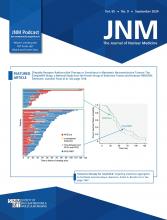TO THE EDITOR: We read with interest the article “Clinical Value of 68Ga-Pentixafor PET/CT in Subtype Diagnosis of Primary Aldosteronism Patients with Adrenal Micronodules,” by Ding et al. (1). The article tested the utility of C-X-C motif chemokine receptor 4 imaging with 68Ga-pentixafor for identification of adrenal microadenomas and differentiating unilateral from bilateral adrenal disease. The authors comment correctly that “existing methods such as 131I-NP-59 and 11C-metomidate have significant shortcomings, including time-consuming acquisition protocols, low specificity, and the need for pretreatment dexamethasone.” Like pentixafor, metomidate is not a functional agent and as a ligand binds to an expressed protein and serves as a measure of expression; metomidate additionally faces challenges given the half-life constraints imposed by the use of 11C as the PET radionuclide. NP-59, developed at our institution, does require dexamethasone suppression of normal cortisol production to unmask abnormal aldosterone.
Additionally, NP-59 is labeled with the isotope 131I, with unfavorable imaging characteristics and dosimetry. However, NP-59 is a functional imaging agent, with its uptake based on steroid production, and has been shown to correlate with adrenal venous sampling in primary aldosterone by Gross et al. (2). Although others have improved the imaging quality of NP-59 through the use 123I or 124I, the longer imaging protocol and dosimetry characteristics limit its utility for routine screening (3).
Ding et al., however, failed to mention that Brooks et al. recently demonstrated an improved 18F version of NP-59, FNP-59, published in The Journal of Nuclear Medicine in 2022 (3). FNP-59 uptake was based on hormone synthesis within the adrenal gland, serving as a true functional imaging agent of cholesterol use by the adrenal gland (3). Although we demonstrated uptake based on hormone synthesis, there were challenges based on biologic uptake in relation to the 18F decay rate. To this end, improvements using an acetyl ester version of FNP-59 have shown significantly improved uptake in the adrenal gland (4) and applications in other pathologies in which altered cholesterol metabolism is present (5). Thus, the ester version of FNP-59 could solve many of the challenges of NP-59, especially in combination with the new total-body PET scanners on the market (6,7), by overcoming the limitations of tracer decay versus biologic uptake. Although pentixafor has a definite place in evaluating adrenal lesions such as nodules, as shown by Ding et al. (1), or adrenocortical carcinoma (8), it has limitations as a nonfunctional agent in trying to quantify where in the adrenal gland hormone dysfunction and autonomy is occurring in situations in which multinodular disease or hyperplasia is present.
DISCLOSURE
No potential conflict of interest relevant to this article was reported.
Benjamin L. Viglianti*, Allen Brooks
University of Michigan Ann Arbor, Michigan
*E-mail: bviglia{at}med.umich.edu
Footnotes
Published online Jul. 25, 2024.
- © 2024 by the Society of Nuclear Medicine and Molecular Imaging.
REFERENCES
- Received for publication April 18, 2024.
- Accepted for publication April 24, 2024.







